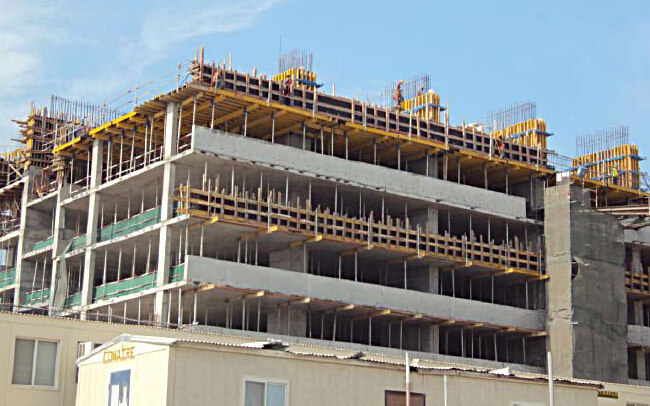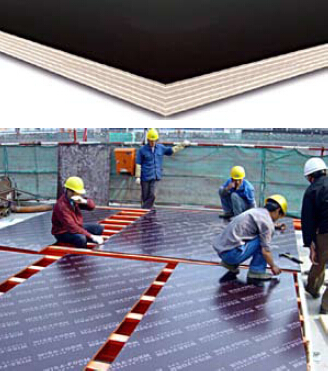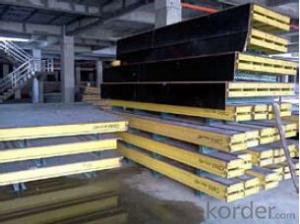Plywood-Formwork system for Formwork and Scaffolding
- Loading Port:
- Tianjin
- Payment Terms:
- TT OR LC
- Min Order Qty:
- 50 m²
- Supply Capability:
- 1000 m²/month
OKorder Service Pledge
Quality Product, Order Online Tracking, Timely Delivery
OKorder Financial Service
Credit Rating, Credit Services, Credit Purchasing
You Might Also Like
Plywood --- make perfect concrete surface
WISA-Form Birch is a coated special plywood using in the formwork systems where high
requirements are set on the concrete surface and the times of reuses.
With CNBM timber beam & WISA plywood, the formwork is low weight but high load capacity, it is
widely used in construction.
Characteristics:
◆ Component with high standardization.
◆ Assembling in site, flexible application.
◆ Light weight, easy transportation and storage.


- Q:How does steel formwork contribute to the overall efficiency of construction processes?
- Steel formwork contributes to the overall efficiency of construction processes in several ways. Firstly, steel formwork is durable and long-lasting, allowing it to be reused multiple times on different construction projects. This reduces the need for frequent replacements, saving both time and money. Additionally, steel formwork can be easily assembled and disassembled, making it quick to set up and dismantle on construction sites. This saves valuable time during the construction process. Furthermore, steel formwork provides high-quality finishes to concrete surfaces. Its smooth and even surface ensures that the concrete is poured and set accurately, resulting in a well-finished product. This eliminates the need for additional finishing work, reducing labor costs and time. The stability and rigidity of steel formwork also prevent any deformation or movement during the pouring and setting of concrete, leading to precise and consistent results. Steel formwork also offers flexibility in design. Its ability to be easily customized and adjusted to different shapes and sizes allows for versatility in construction projects. This adaptability reduces the need for multiple types of formwork, streamlining the construction process. Moreover, steel formwork is resistant to weather conditions, chemicals, and moisture, ensuring its durability even in harsh environments. This resistance reduces the likelihood of damage or deterioration, minimizing the need for repairs and replacements. The longevity of steel formwork contributes to cost savings and increases the overall efficiency of construction processes. In summary, steel formwork greatly contributes to the overall efficiency of construction processes through its durability, reusability, easy assembly, high-quality finishes, flexibility in design, and resistance to weather and chemicals. These benefits save time, reduce costs, and ensure the construction project is completed efficiently and effectively.
- Q:Can steel formwork be used for both vertical and horizontal concrete structures?
- Yes, steel formwork can be used for both vertical and horizontal concrete structures. Steel formwork is versatile and strong enough to support the weight of concrete in various orientations, making it suitable for both vertical walls and horizontal slabs.
- Q:What are the different types of bracing used with steel formwork?
- There are several types of bracing commonly used with steel formwork, including diagonal bracing, horizontal bracing, and vertical bracing. Diagonal bracing is used to provide stability and resistance against lateral forces, while horizontal bracing helps to control deflection and ensure the formwork remains in place. Vertical bracing is used to support the formwork system vertically and prevent any potential collapse. These different types of bracing work together to ensure the safety and stability of the steel formwork during construction.
- Q:Can steel formwork be used for both reinforced and non-reinforced concrete structures?
- Absolutely! Steel formwork is applicable to both reinforced and non-reinforced concrete structures. This flexible and long-lasting choice can endure the immense pressure generated by the concrete during pouring. Moreover, it can be effortlessly put together and taken apart, making it ideal for diverse construction undertakings. Whether it's a reinforced structure necessitating supplementary reinforcement bar support or a non-reinforced structure requiring a temporary mold, steel formwork proves effective in either scenario. Its robustness and steadiness enable the achievement of accurate shapes and measurements, guaranteeing the desired result for any concrete structure.
- Q:How does steel formwork contribute to the overall structural integrity of the building?
- Steel formwork contributes to the overall structural integrity of a building in several ways. Firstly, steel formwork provides strong and durable support for the concrete during the construction process. The use of steel ensures that the formwork does not deform or collapse under the weight of the concrete, leading to a more stable and secure structure. Additionally, steel formwork allows for precise and accurate shaping of the concrete, ensuring that the building components are constructed to the required dimensions and specifications. This level of precision is essential for maintaining the structural integrity of the building, as any deviations from the intended design can compromise its stability and safety. Furthermore, steel formwork provides excellent resistance to external forces such as wind, earthquakes, and other environmental loads. The inherent strength and rigidity of steel make it highly resistant to deformation, ensuring that the formwork can withstand these forces without compromising the structural integrity of the building. Moreover, steel formwork is resistant to moisture and other corrosive elements, which can significantly impact the durability and longevity of the structure. By using steel formwork, the risk of deterioration and structural damage due to moisture, rust, or other corrosive agents is minimized, thereby enhancing the overall structural integrity of the building. Lastly, steel formwork allows for efficient construction processes, reducing the time and labor required for building construction. This efficiency not only ensures cost-effectiveness but also minimizes the potential for errors and defects during the construction, thereby further enhancing the structural integrity of the building. In conclusion, steel formwork plays a crucial role in contributing to the overall structural integrity of a building. Its strength, durability, precision, resistance to external forces and corrosion, as well as its contribution to efficient construction processes, all combine to ensure a safe, stable, and long-lasting structure.
- Q:Can steel formwork be used in areas with extreme temperature variations?
- Yes, steel formwork can be used in areas with extreme temperature variations. Steel is known for its durability and strength, which allows it to withstand various temperature conditions. However, it is important to consider potential expansion and contraction of the steel due to temperature changes, and take appropriate measures to prevent any negative effects on the formwork structure.
- Q:Can steel formwork be used in high-rise construction?
- Yes, steel formwork can be used in high-rise construction. Steel formwork offers high strength and durability, making it suitable for withstanding the high pressures and loads experienced in tall buildings. It also provides excellent dimensional accuracy, allowing for precise construction and ensuring the structural integrity of the high-rise building. Furthermore, steel formwork can be easily assembled and disassembled, making it a time-efficient choice for large-scale projects.
- Q:Can steel formwork be used for both residential and institutional projects?
- Yes, steel formwork can be used for both residential and institutional projects. Steel formwork is a versatile and durable construction material that is suitable for a wide range of projects, including both residential and institutional buildings. It is commonly used in the construction industry due to its strength, stability, and reusability. Steel formwork provides a robust and sturdy framework for pouring concrete, helping to create precise and well-structured structures. Its ability to withstand high pressures and loads make it suitable for large-scale institutional projects such as schools, hospitals, and government buildings. At the same time, steel formwork can also be utilized in residential projects, including single-family homes, apartment complexes, and townhouses. Its versatility allows for flexible and efficient construction methods, making it a popular choice for various types of projects.
- Q:Can steel formwork be used for both symmetrical and asymmetrical concrete elements?
- Steel formwork can be utilized for both symmetrical and asymmetrical concrete elements, rendering it highly adaptable and capable of meeting the specific needs of any concrete structure, regardless of its shape or intricacy. It possesses the advantage of easy adjustability, facilitating the creation of both symmetrical and asymmetrical shapes. Furthermore, steel formwork offers exceptional strength and durability, guaranteeing its ability to withstand the pressure exerted by the concrete throughout the pouring and curing process. As a result, it proves to be a fitting choice for an extensive array of concrete elements, encompassing walls, columns, beams, slabs, and beyond.
- Q:What are the different types of concrete finishes achievable with steel formwork?
- There are several different types of concrete finishes that can be achieved with steel formwork, including smooth finishes, textured finishes, exposed aggregate finishes, and stamped finishes. Each finish can be customized to achieve the desired aesthetic and texture for the concrete surface.
1. Manufacturer Overview |
|
|---|---|
| Location | |
| Year Established | |
| Annual Output Value | |
| Main Markets | |
| Company Certifications | |
2. Manufacturer Certificates |
|
|---|---|
| a) Certification Name | |
| Range | |
| Reference | |
| Validity Period | |
3. Manufacturer Capability |
|
|---|---|
| a)Trade Capacity | |
| Nearest Port | |
| Export Percentage | |
| No.of Employees in Trade Department | |
| Language Spoken: | |
| b)Factory Information | |
| Factory Size: | |
| No. of Production Lines | |
| Contract Manufacturing | |
| Product Price Range | |
Send your message to us
Plywood-Formwork system for Formwork and Scaffolding
- Loading Port:
- Tianjin
- Payment Terms:
- TT OR LC
- Min Order Qty:
- 50 m²
- Supply Capability:
- 1000 m²/month
OKorder Service Pledge
Quality Product, Order Online Tracking, Timely Delivery
OKorder Financial Service
Credit Rating, Credit Services, Credit Purchasing
Similar products
New products
Hot products
Related keywords























